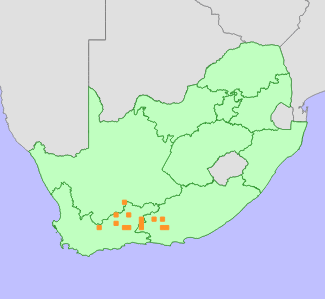|
Scientific Name | Curio hallianus (G.D.Rowley) P.V.Heath |
Higher Classification | Dicotyledons |
Family | ASTERACEAE |
Synonyms | Senecio hallianus G.D.Rowley |
National Status |
Status and Criteria | Least Concern |
Assessment Date | 2019/11/05 |
Assessor(s) | P.V. Bruyns, D. Raimondo & D.A. Kamundi |
Justification | Curio hallianus is a widespread, but poorly known species, with an extent of occurrence (EOO) of 27 438 km². It has no severe threats and is therefore not suspected to be in danger of extinction. It is listed as Least Concern. |
Distribution |
Endemism | South African endemic |
Provincial distribution | Eastern Cape, Northern Cape, Western Cape |
Range | This species is endemic to the central Karoo in South Africa, where it occurs between Prince Albert, Loxton and Merweville. |
Habitat and Ecology |
Major system | Terrestrial |
Major habitats | Eastern Upper Karoo, Eastern Lower Karoo, Gamka Karoo, Central Mountain Shale Renosterveld, Southern Karoo Riviere |
Description | It occurs in sheltered places among the roots of shrubs and in rocky crevices. |
Threats |
| There are currently no severe threats to Curio hallianus, but its entire known range falls within an area earmarked for shale gas fracking, which is likely to cause significant population decline if it is to go ahead.
A Strategic Environmental Impact Assessment submitted to South Africa's Department of Environment Affairs in 2016 cautioned against the authorisation of shale gas fracking, based on the very high infrastructure costs associated with fracking as well as multiple secondary negative impacts both to biodiversity and other economic activities in the region. Furthermore, subsequent geological studies have found that gas deposits are not as substantial as originally suspected due to the very old age of the Karoo shale formations, and the effect of widespread dolerite intrusions that resulted in much of the gas being lost. At present, future development scenarios are too uncertain to estimate the potential extent of the impact on the population but it is unlikely that shale gas fracking will proceed in the near future. |
Population |
This is a widespread, but rarely collected and poorly known species. It is likely to be under-sampled as its distribution range is botanically poorly explored. The population is not suspected to be declining, but may be severely impacted in future if planned shale gas fracking is to go ahead.
|
Population trend | Stable |
Assessment History |
Taxon assessed |
Status and Criteria |
Citation/Red List version | | Curio hallianus (G.D.Rowley) P.V.Heath | LC | 2017.1 | | Senecio hallianus G.D.Rowley | Rare | Raimondo et al. (2009) | |
Bibliography |
Eggli, U. (ed). 2001. Illustrated handbook of succulent plants: Dicotyledons. Springer, Berlin Heidelberg.
Heath, P.V. 1999. Three new generic names in the Asteraceae (part 2). Calyx 6(2):54-55.
Raimondo, D., von Staden, L., Foden, W., Victor, J.E., Helme, N.A., Turner, R.C., Kamundi, D.A. and Manyama, P.A. 2009. Red List of South African Plants. Strelitzia 25. South African National Biodiversity Institute, Pretoria.
Rowley, G.D. 1994. Succulent Compositae. Strawberry Press, California.
Snijman, D.A. 2013. Plants of the Greater Cape Floristic Region 2: The extra Cape flora. Strelitzia 30. South African National Biodiversity Institute, Pretoria.
|
Citation |
| Bruyns, P.V., Raimondo, D. & Kamundi, D.A. 2019. Curio hallianus (G.D.Rowley) P.V.Heath. National Assessment: Red List of South African Plants version . Accessed on 2025/09/19 |
 Comment on this assessment
Comment on this assessment


